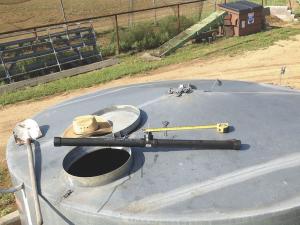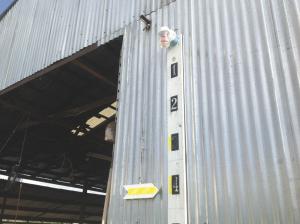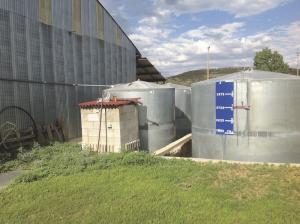Mechanical Gauges Track Water Storage Levels
With rainwater capture and storage on multiple buildings, Dean Steward had trouble keeping track of water levels vital for watering gardens and livestock on his Arizona homestead. Now, thanks to his mechanical gauges, he can check water levels at a glance. He can also see if water pumps are running.
“I have multiple, redundant, water storage systems that hold 23,000 gal. total,” says Steward. “Each one is used for a purpose, like watering the garden and fruit trees or watering livestock. If one gets low, I have to move water to it from one of the other tanks. I used to have to walk around and pound on tanks to check levels. Now I just look out my kitchen window.”
Steward, a wildland firefighter, puts a high value on water. As his area gets only 15 in. of rainfall a year, every drop is precious. He has collected rainwater since moving to Arizona 23 years ago. What started out as 55-gal. drums at barn downspouts has become a sophisticated system of tanks, cisterns, pipes and valves. The system includes a Quonset-style, steel arch building.
“At the bottom edge on each side, I built rain gutters,” explains Steward. “They feed water into a 100-gal. cistern I constructed out of cinder blocks under the apron of the building.”
House water is provided by a windmill that pumps to a tank at the wellhead, from which it can be pumped uphill to a storage tank. Like other buildings, the house also catches water with rain gutters feeding into an 1,800-gal. cistern next to it.
Pipes connect adjacent tanks, as well as the individual tanks and cisterns. This helps when tanks are getting low as well as when rain is falling.
“When I see a set of tanks is full, I can open valves to another storage unit not yet filled to keep from losing water on the ground,” says Steward.
His mechanical water gauges are relatively simple. Floats are made out of pvc pipe and 70 percent filled with water and bleach to make them heavier. Light gauge aircraft cable runs from the floats up over pulleys to large pointers that move up and down on scales of reflective numbers.
“I can see five of them from the house,” says Steward.
A large set of 4 tanks that hold 13,500 gal. total is on the opposite side of the barn. They’re all plumbed together so the cable attaches to a float in one tank. It runs through a set of pulleys down the full length of the barn to a gauge. In another case, cables from 2 separate storage tanks, one 150 ft. away, drive markers to either side of a single reflective scale.
If necessary, Steward can use rainwater for drinking water. All water to the house passes through a UV filter to kill bacteria.
Also visible from his kitchen window are warning lights from each of the 3 pump houses scattered around the buildings.
“When I’m gone, my neighbors can keep an eye on the pumps,” he says. “If you run out of water, you burn out an irrigation pump, and you’re out $200 to $300. I’ve done that.”
Contact: FARM SHOW Followup, Dean Steward, P.O. Box 444, Dewey, Arizona 86327 (ph 928 713-5085; dsteward@hotmail.com).

Click here to download page story appeared in.
Mechanical Gauges Track Water Storage Levels FARM HOME Miscellaneous With rainwater capture and storage on multiple buildings Dean Steward had trouble keeping track of water levels vital for watering gardens and livestock on his Arizona homestead Now thanks to his mechanical gauges he can check water levels at a glance He can also see if water pumps are running “I have multiple redundant water storage systems that hold 23 000 gal total ” says Steward “Each one is used for a purpose like watering the garden and fruit trees or watering livestock If one gets low I have to move water to it from one of the other tanks I used to have to walk around and pound on tanks to check levels Now I just look out my kitchen window ” Steward a wildland firefighter puts a high value on water As his area gets only 15 in of rainfall a year every drop is precious He has collected rainwater since moving to Arizona 23 years ago What started out as 55-gal drums at barn downspouts has become a sophisticated system of tanks cisterns pipes and valves The system includes a Quonset-style steel arch building “At the bottom edge on each side I built rain gutters ” explains Steward “They feed water into a 100-gal cistern I constructed out of cinder blocks under the apron of the building ” House water is provided by a windmill that pumps to a tank at the wellhead from which it can be pumped uphill to a storage tank Like other buildings the house also catches water with rain gutters feeding into an 1 800-gal cistern next to it Pipes connect adjacent tanks as well as the individual tanks and cisterns This helps when tanks are getting low as well as when rain is falling “When I see a set of tanks is full I can open valves to another storage unit not yet filled to keep from losing water on the ground ” says Steward His mechanical water gauges are relatively simple Floats are made out of pvc pipe and 70 percent filled with water and bleach to make them heavier Light gauge aircraft cable runs from the floats up over pulleys to large pointers that move up and down on scales of reflective numbers “I can see five of them from the house ” says Steward A large set of 4 tanks that hold 13 500 gal total is on the opposite side of the barn They’re all plumbed together so the cable attaches to a float in one tank It runs through a set of pulleys down the full length of the barn to a gauge In another case cables from 2 separate storage tanks one 150 ft away drive markers to either side of a single reflective scale If necessary Steward can use rainwater for drinking water All water to the house passes through a UV filter to kill bacteria Also visible from his kitchen window are warning lights from each of the 3 pump houses scattered around the buildings “When I’m gone my neighbors can keep an eye on the pumps ” he says “If you run out of water you burn out an irrigation pump and you’re out $200 to $300 I’ve done that ” Contact: FARM SHOW Followup Dean Steward P O Box 444 Dewey Arizona 86327 ph 928 713-5085; dsteward@hotmail com
To read the rest of this story, download this issue below or click
here to register with your account number.








